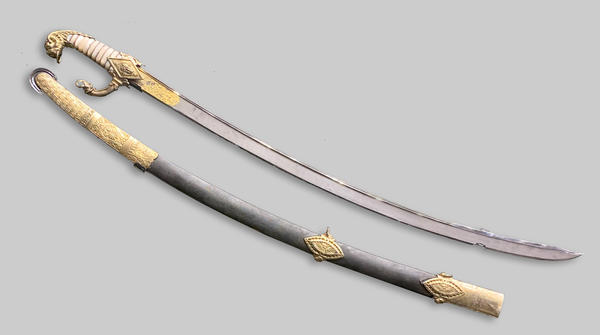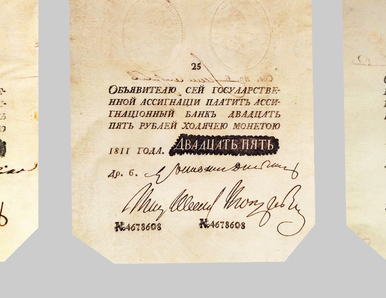In the 19th century, a sabre was an indispensable attribute of its owner’s high status. First Consul Napoleon Bonaparte received a weapon made from damask steel not long before he was proclaimed Emperor of all the French. A bent blade is added with an yalman, a thickened part behind the point designed to make a cutting blow stronger. A bronze hilt is gold-plated, the mother-of-pearl grip is adorned with golden wire. A brass pommel that completes the grip passes through into a lion head with a ring. The arch of the hand guard in the form of a snake thrusts against the quillon. The scabbard made from black leather is ornamented with embossed work in the form of oak leaves. Lion heads adorn the scabbard throat and nut.
Napoleon had a similar sabre, but with no ornaments at the battle of Marengo where his talent of a military leader manifested itself in full measure. However, Napoleon’s dress weapon turned out in Russia not as result of hostilities. It had been preceded by a very unusual incident. In 1814 the deposed emperor abdicated and signed the respective document in Fontainbleau. Escorted by the officers from the winner-countries Napoleon was taken to the port of Frejus on the Cote d’Azur. A ship was waiting there to send him in exile to the island of Elba.
Russia was represented in the guard of honour by Adjutant General Count Pavel Shuvalov, a participant of the Italian and Swiss expeditions led by Suvorov. At the Saint-Gothard pass he was heavily wounded in the knee and became a diplomat. He was known for his bonhhomie and was in the favour of Emperor Alexander I. He participated in all major battles of the Patriotic War, for bravery he was awarded Prussian and Russian orders.
In Avignon the crowd encircled the carriage of the fallen emperor and threw stones at it with cries ‘Down with the tyrant! ’ The same happened in Orgon where peasants nearly dragged Napoleon outside to kill him. Count Shuvalov pushed the furious mob aside and covered Bonaparte with his body. The formidable look of the Russian officer tamed the crowd and the cortege left the village. On arrival at the island of Elba Napoleon presented the savior with his personal dress sabre as a token of gratitude. It was kept in the mansion house of his graddaughter Vorontsova-Dashkova and was exhibited in 1912 at the event to commemorate the 100th anniversary of the Patriotic War.
In 1918, the mansion house was ransacked and the sabre disappeared without a trace. But 4 years later it was transferred from the Red Army Museum to the Historical Museum with a cover letter stating that it was brought from the civil war fronts by a certain commissar cavalry man. The proof of the Russian officer’s bravery and respect for the defeated but great enemy found its way to the museum’s show case in such a convoluted way.
Napoleon had a similar sabre, but with no ornaments at the battle of Marengo where his talent of a military leader manifested itself in full measure. However, Napoleon’s dress weapon turned out in Russia not as result of hostilities. It had been preceded by a very unusual incident. In 1814 the deposed emperor abdicated and signed the respective document in Fontainbleau. Escorted by the officers from the winner-countries Napoleon was taken to the port of Frejus on the Cote d’Azur. A ship was waiting there to send him in exile to the island of Elba.
Russia was represented in the guard of honour by Adjutant General Count Pavel Shuvalov, a participant of the Italian and Swiss expeditions led by Suvorov. At the Saint-Gothard pass he was heavily wounded in the knee and became a diplomat. He was known for his bonhhomie and was in the favour of Emperor Alexander I. He participated in all major battles of the Patriotic War, for bravery he was awarded Prussian and Russian orders.
In Avignon the crowd encircled the carriage of the fallen emperor and threw stones at it with cries ‘Down with the tyrant! ’ The same happened in Orgon where peasants nearly dragged Napoleon outside to kill him. Count Shuvalov pushed the furious mob aside and covered Bonaparte with his body. The formidable look of the Russian officer tamed the crowd and the cortege left the village. On arrival at the island of Elba Napoleon presented the savior with his personal dress sabre as a token of gratitude. It was kept in the mansion house of his graddaughter Vorontsova-Dashkova and was exhibited in 1912 at the event to commemorate the 100th anniversary of the Patriotic War.
In 1918, the mansion house was ransacked and the sabre disappeared without a trace. But 4 years later it was transferred from the Red Army Museum to the Historical Museum with a cover letter stating that it was brought from the civil war fronts by a certain commissar cavalry man. The proof of the Russian officer’s bravery and respect for the defeated but great enemy found its way to the museum’s show case in such a convoluted way.



